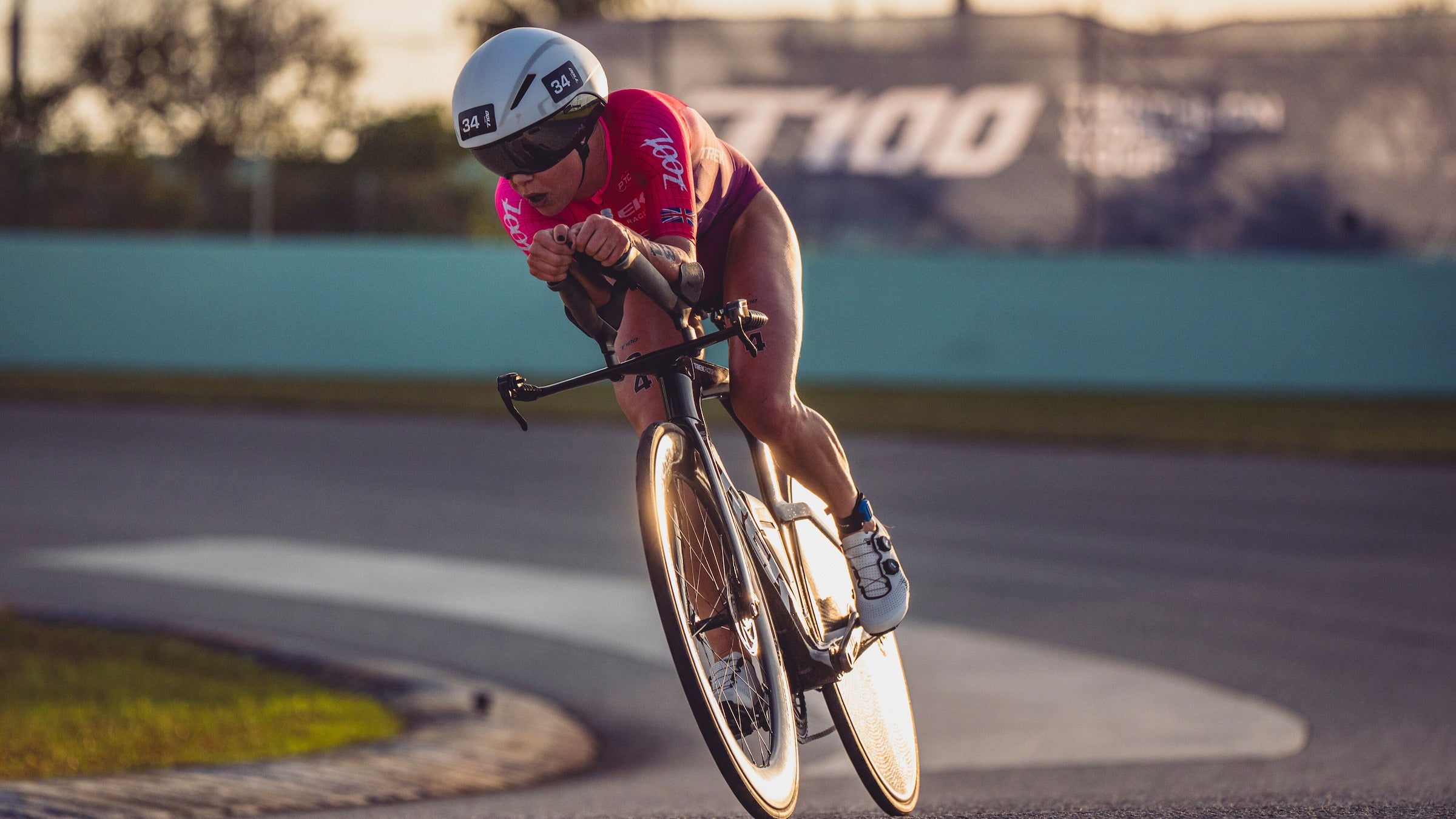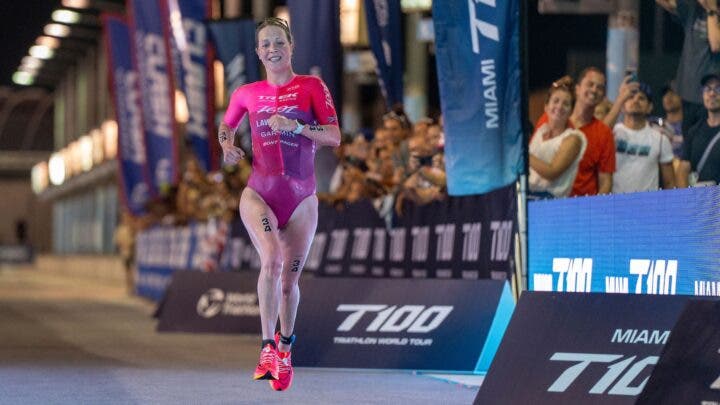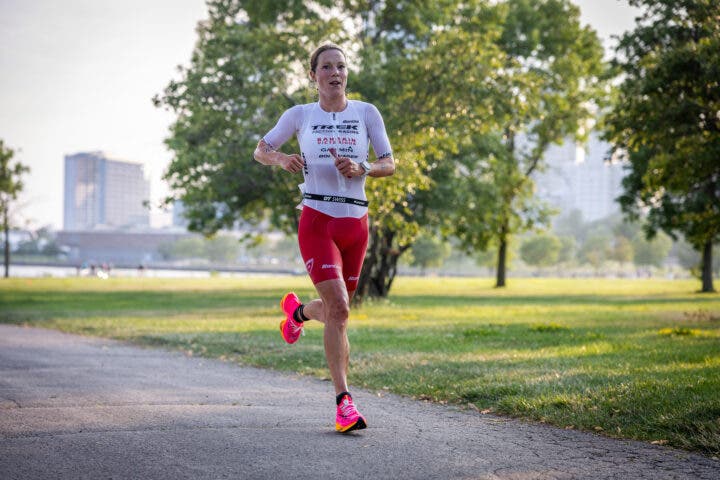How Pregnancy Inspired Holly Lawrence to (Finally) Race Her First Ironman

Holly Lawrence competes in T100 Miami in 2024 right before announcing her pregnancy. Now she shares how motherhood has motivated her next pro triathlete goal. (Photo: T100)
Holly Lawrence is no stranger to racing on the edge. The 2016 Ironman 70.3 World Champion has built a career on relentless drive and grit, racing from the front. But in 2024, Lawrence embarked on a new endurance journey: pregnancy and motherhood. Just four months after welcoming her daughter, Poppy, Lawrence is already eyeing her next challenge: racing her first Ironman in 2025 and qualifying for the Ironman World Championship in Kona.
Triathlon training through pregnancy: A new experience

For elite athletes, pregnancy can often feel like uncharted waters. Even as more professional athletes balance parenthood and competition, Lawrence was frustrated by the lack of tailored guidance available for athletes. She turned to podcasts featuring elite runner moms like Ellie St. Pierre and Molly Huddle, searching for the best approach to training through pregnancy. Most advice emphasized that training during pregnancy is highly individual – there’s no one-size-fits-all approach, so athletes must rely on intuition and adaptation.
“It’s crazy how little information is out there for athletes,” she says. “It was trial-and-error for me, figuring out what felt right.”
Lawrence kept moving – within reason. Swimming and cycling remained manageable early in her pregnancy, though running had to be shelved by week 15, despite initial optimism that she would be able to maintain her routine across all three sports.
“Honestly I never thought that would be me,” Lawrence recalls, “I thought I was going to be the one person that could swim, bike, and run all the way through pregnancy.”
Though she planned to run longer, Lawrence realized her body dictated what was possible – and she learned to respect that. Some days, even her favorite disciplines proved too much.
“There were days I’d set out for a three-hour ride and turn back after 30 minutes because I just didn’t have the energy,” she shares. “It wasn’t about pushing through; I had to listen to what my body was telling me.”
Postpartum hurdles and small victories
Breastfeeding-induced stress reaction
Lawrence’s postpartum return to training has been marked by joy and setbacks. Initially, swimming and cycling came back quickly. Running, however, has brought complications. Five weeks into her return-to-run program, she was sidelined with a sacral stress reaction.
“I did everything I could to avoid it with the limited knowledge available, but it still happened,” she says. Working with her nutritionist, Scott Tindal, she carefully managed her postpartum nutrition, intentionally maintaining 4kg above her pre-pregnancy weight to support the demands of breastfeeding.
Through her research on other elite athletes, Lawrence identified six months as a key time when many experienced bone stress injuries, likely linked to calcium loss from breastfeeding.
“I realized calcium loss from breastfeeding and pumping had likely played a role,” she says. Working with a lactation consultant, Lawrence began pumping milk several weeks before birth, stockpiling colostrum for her postpartum supply. While it boosted her milk production, she believes it also contributed to calcium depletion. “I was producing milk like crazy, enough for twins, and that takes a toll on your body.”
While blood tests didn’t reveal a calcium deficiency and DEXA scans showed normal bone density, Lawrence, in consultation with doctors, feels this is the best explanation for the bone stress injury occurring six months after she started pumping breast milk.
“It’s just something that every athlete, if they’re breastfeeding, has to be super-careful of,” she explains. While she’s frustrated, Lawrence admits that she’s glad it happened relatively early postpartum. “If it was at six months or seven months postpartum, then that would possibly have derailed my season.” Instead, she considers it a minor setback rather than an injury, and is already back to a little running.
Lawrence’s experience underscores the need for better research and resources. “There’s so much we don’t know about pregnancy and sport,” she says. “Even basic things like how calcium loss impacts bone health postpartum aren’t widely understood. We need more studies and shared experiences.”
Postpartum atrial fibrillation
The bone stress injury isn’t the only health scare Lawrence has faced since giving birth to her daughter. Weeks after giving birth, she experienced atrial fibrillation during a light indoor cycling session.
“I was on the deck, riding at 140 watts, not even looking at my cycling computer,” she says. “Suddenly, I felt this fluttery feeling in my chest. When I checked, my heart rate was at 230. It was terrifying.”
Her husband and coach, Sean Jefferson, rushed to help as they contacted her doctor. “The doctor calmly explained it was likely related to the massive physical changes postpartum, combined with fatigue and dehydration,” she says. Lawrence converted back to normal sinus rhythm later that day and has not experienced any further arrythmias.
Despite these setbacks, Lawrence has found joy in focusing on her strengths. “I’ve leaned into swimming and biking,” she says. “Long rides have always been my escape. They remind me why I love this sport.”
Holly Lawrence, mom and pro triathlete
Since becoming a mom, Holly Lawrence has embraced a new level of balance and purpose in her triathlon training, working closely with Jefferson to navigate the demands of both sport and family life. With Jefferson coaching from home, they’ve established a routine that balances training and parenting.
“Sean’s been incredible,” she says. “We’ve found a rhythm that works and having him there makes everything easier.”
Motherhood has given her training new purpose – it’s no longer something to put off but a privilege she cherishes. “I feel like my training is way more meaningful now. Before if I had an indoor training ride and I’ve got literally all day to do it, I would just waste time and procrastinate; do it at the last minute,” she reflects.
But I think now it's really not lost on me that I still get to do this and have a baby.
With her days now carefully structured around training sessions, parenting responsibilities, and recovery, time management has become crucial to making it all work.
“I’ve got to be smarter with my time. It’s got to work for me, Sean, and Poppy,” she says. Even with the inevitable unpredictability that comes with parenting, she finds satisfaction in making it all fit. “It’s a feeling of accomplishment when it all kind of goes smoothly and you time it well.”
Despite the inevitable ups and downs of any athlete’s journey, the mental shift of motherhood has been particularly profound for Lawrence. “Once I finish a session, it’s done. I don’t obsess over whether it was good or bad,” she says. “Poppy gives me a whole new perspective – there’s no room to stress about workouts, because my focus is back on her the moment I’m done. It’s freeing, in a way.”
A renewed love for triathlon
Lawrence’s journey through pregnancy has reinforced her deep love for triathlon in a way she hadn’t expected.
“I think when you enter pregnancy as a professional athlete, you don’t know how you’re going to come out the other side of it, it could be the end,” she says. The uncertainty made her appreciate the sport even more. “I love the day-to-day of this, and I want this to last as long as possible because it’s a dream job!”
Unlike when she suffered a navicular fracture in her foot during the 2017-2018 season – an injury that left her unable to even watch the Ironman 70.3 World Championships because of the frustration and negativity she felt – Lawrence says her mindset during pregnancy has been entirely different: “I couldn’t even look at the sport back then. I didn’t watch Worlds that year [2018] because I wasn’t part of it, and I had a very negative headspace about it all.”
During pregnancy, she remained engaged with the triathlon community and found joy in supporting others. “When I was pregnant, I still went to [Ironman 70.3] St. George and supported my friends, and I thought to myself how much I love the sport,” she says. Rather than feeling sidelined, she embraced the experience and trained as much as possible while staying involved in the sport.
“I was stoked to be training. And I couldn’t wait to be back in the sport, but I was also excited just to be around it as much as I could,” she says. Her renewed passion is carried into her postpartum return, reminding her that triathlon isn’t just a profession – it is a fundamental part of who she is.
Holly Lawrence on racing her first Ironman (and big Kona dreams)

For Lawrence, qualifying for the Ironman World Championship in Kona has become a top priority – something she’s always envisioned but never pursued until now.
“I’ve waited long enough, and I always knew I wanted to do Kona,” she says. The heat, the wind, and the legendary lava fields have long captured her imagination, but until recently, the timing never felt right.
“After having Poppy, I realized I didn’t want to wait anymore. It’s time to see what I can do at a full Ironman.” Her decision to target Kona in 2025 is a bold one, marking a major shift from her decorated middle-distance career to the grueling demands of the full-distance race. Having witnessed the race’s prestige firsthand – whether watching from home or experiencing the event atmosphere in person – Lawrence understands exactly what she’s up against.
“Even after the first time I went to Kona and realized how much of a big deal it is, just the energy of it all, it became super clear that I wanted to be there,” she explains.
With Kona’s future as an Ironman world championship host location uncertain, Lawrence knows now is the time to make it happen. “We don’t know what will happen to Kona, we don’t know if it’s going to stay there, and it’s a race that I definitely want to check off the bucket list,” she says.
With Kona’s brutal conditions known for breaking even the best athletes – where “people end up in ambulances” – Lawrence is methodically preparing herself for the unique demands of the race. Her plan is simple but effective: focus on her strengths, nail the fundamentals, and gradually build the durability needed for the full distance.
“The long training days excite me,” she admits. “Even during pregnancy, I loved those big rides. They’re like therapy for me.”
With her renowned swim and bike strength as a foundation, she is taking a careful approach to rebuilding her run while placing a strong emphasis on heat acclimatization and race-day nutrition.
“I’ve been focusing on nailing the basics and making every session count,” she says. “It’s about being smart with my time.”
A new triathlon era for Holly Lawrence
With her sights set firmly on Kona, Lawrence is relishing the opportunity to write a new chapter in her career.
“I’ve got so much more to give as an athlete,” she says. “And Kona feels like the perfect stage to prove it.”
For Lawrence, the journey is as much about personal growth as it is about competition. “Motherhood has given me a new perspective,” she says. “Every session feels more meaningful now. I’m not just doing this for me anymore – it’s for my family, too.”
Lawrence admits that qualifying for and racing in Kona will be one of the toughest challenges of her career, but she’s ready to embrace it. “I know it’s going to be hard, but that’s what makes it worth it,” she says. “I’m excited to see what I’m capable of.”